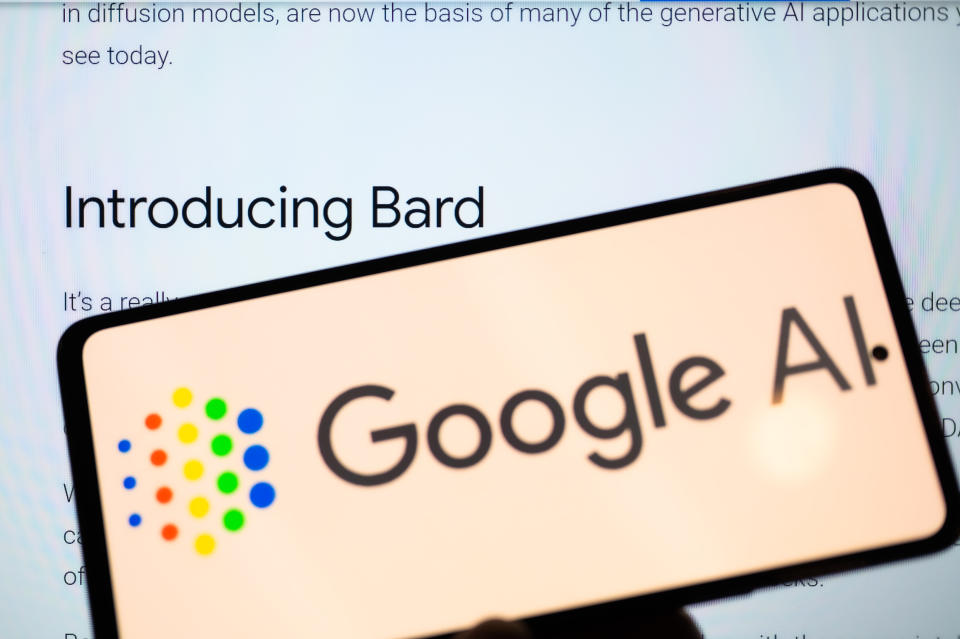Google’s parent company Alphabet (GOOGL) has announced the launch of its own AI content generator called Bard that could rival ChatGPT, which now has over 100 million users and the recipient of a $10bn (£8.3bn) investment from Microsoft (MSFT).
Since Microsoft’s investment in ChatGPT reports have emerged that the AI-tool could be used to create a new version of Microsoft’s Bing search engine that could threaten the dominance of Google search.
Read more: Microsoft’s ChatGPT investment could create ‘game-changer’ AI search engine
Google has said the new AI-tool will soon be made available to “trusted users” prior to a wider, public release in upcoming weeks. In a blog it announced that the AI artificial features made available by the Bard chatbot “will begin rolling out on Google Search soon”.
This would affect the way Google responds to search queries. In the future, instead of providing a series of links in response to your query, it would provide a paragraph of text which the AI has composed having digested those links.
Alphabet CEO Sundar Pichai explained plans to provide chatbot-based artificial intelligence capabilities for both its search engine and for the development of other Google apps.
What is Bard?
Bard is Alphabet’s version of artificial intelligence content generation tool ChatGPT, and has been hailed by the company’s CEO as “an outlet for creativity, and a launchpad for curiosity”.
It has been in development by Google Research for many months, but the the company only announced its existence less than two weeks after Microsoft disclosed it’s multi-billion dollar investment in ChatGPT’s parent, OpenAI.
Google’s Bard and its rival ChatGPT, are known as AI chatbots, or generative AI applications. They are trained on vast amounts of text data already available online.
These AI-tools generate text-based answers to prompts given by users. Examples of user prompts can be as simple as “what is the tallest mountain in the world”, or as complex as “write a book detailing the fundamentals of quantum mechanics”.
They are able to conduct human-like conversations with users and through a process of questions (prompts) and answers a vast array of written content can be produced within seconds. In addition to text responses, both Bard and OpenAI offer multimedia information, including images, videos, and audio.
Read more: How ChatGPT could lead to ‘mass unemployment’ – The Crypto Mile
Referring to the new chatbot’s capabilities, Alphabet CEO Sundar Pichai said: “Bard can be an outlet for creativity, and a launchpad for curiosity, helping you to explain new discoveries from NASA’s James Webb Space Telescope to a nine-year-old, or learn more about the best strikers in football right now, and then get drills to build your skills.”
He added: “It’s a really exciting time to be working on these technologies as we translate deep research and breakthroughs into products that truly help people.
“That’s the journey we’ve been on with large language models.”
Chatbots have the potential to transform the way people prepare for job interviews, create academic papers, write social media posts, produce poems in the style of Shakespeare or TS Elliot, and even help journalists craft articles such as this one.
How does Bard differ from ChatGPT?
At present the large data store that ChatGPT draws from to mimic human-like language responses is not up to date, and anything after 2021 is not included. This means that ChatGPT does not give the most up to date information based upon recent trawls of the internet.
In contrast, Bard benefits from Google’s extensive reach, access to information, and a wider range of media offerings.
Although Microsoft intends to integrate ChatGPT into its Bing search engine, Bing’s market share is low, only accounting for less than 10% of online searches.
Compare this to Google’s dominant 80% market share, and if both chatbots are evolving based upon user question inputs, Google’s offering could outpace its rival.
To put this into perspective, ChatGPT has 100 million users, but if Google incorporates its chatbot into the dominant Google search engine, it could immediately onboard approximately one billion daily active users.
Bard utilises a smaller version of Google’s LaMDA AI model. LaMDA stands for Language Model for Dialogue Applications and it is trained specifically to hold human-like conversations. LaMDA is a large neural network that mimics the way human neurons work in the brain, making it;s language process seem human-like and natural.
ChatGPT uses the GPT-3.5 model at the moment, but Microsoft plans to use GPT-4 to be incorporated into its Bing search engine, which may bring it closer to its rival in terms of how recent the data is that it uses, and its overall quality.
Will Bard be incorporated into Google Search?
The Google Bard AI chatbot is expected to be integrated into Google Search once it is made available to the wider public.
Users will be able to access it by asking questions through the search bar, with the chatbot obtaining information from the web to offer current answers to text queries.
Google’s Sundar Pichai explained that Bard will be capable of drawing on “information from the web to provide fresh, high-quality responses” and enhance our comprehension of information provided through internet search engines.
Adding that using AI-assisted internet search engines will allow information to be converted into knowledge that is tailored to suit each user. Pichai explained that the Bard AI-content generator will enable users to quickly grasp key concepts and expand their knowledge by accessing additional perspectives when they use Google search.
In his blog post he added: “Artificial intelligence will make it easier for people to get to the heart of what they’re looking for and get things done.
“When people think of Google, they often think of turning to us for quick factual answers, like “how many keys does a piano have?” But increasingly, people are turning to Google for deeper insights and understanding, like, “is the piano or guitar easier to learn, and how much practice does each need?”
“Learning about a topic like this can take a lot of effort to figure out what you really need to know, and people often want to explore a diverse range of opinions or perspectives.”
Can anyone use Google’s Bard chatbot?
Google said it would give “trusted testers” first access to Bard, and will make it available to the wider public “in the coming weeks”. However, the exact launch date for the Google Bard AI chatbot has yet to be confirmed, and there is currently no website that can be accessed to sign up to use the new generative AI tool.
Explaining how Bard would be rolled-out to users, Pichai wrote: “We’re releasing it initially with our lightweight model version of LaMDA.
“This much smaller model requires significantly less computing power, enabling us to scale to more users, allowing for more feedback.
“We’ll combine external feedback with our own internal testing to make sure Bard’s responses meet a high bar for quality, safety, and groundedness in real-world information.
“We’re excited for this phase of testing to help us continue to learn and improve Bard’s quality and speed.”
Who else is in the race?
Meta (META), the owner of Facebook, WhatsApp and Instagram, unveiled its own chatbot, called Galactica, before the release of ChatGPT in November 2022.
Like OpenAI’s ChatGPT, Galactica gave responses that were littered with factual errors. However, in contrast to OpenAI, Meta received a flood of complaints over Galactica’s errors. After just three days, the company, which has faced criticism for its role in promoting misinformation and hate speech through its social networking apps, took Galactica offline.
At a recent gathering of Silicon Valley leaders and thinkers, called Collective[i] Forecast, Meta’s Chief Artificial Intelligence Scientist Yann LeCun stated: “The creators of the Galactica demo had to remove it due to the overwhelming criticism they received.”
LeCun added that Meta also released a chatbot early in 2022 called BlenderBot, which he claimed pushed the limits of generative AI. However, he noted that it failed to gain popularity because the company took measures to prevent it from generating inappropriate content.
A Chinese version of ChatGPT will be incorporated into the nation’s official Baidu search engine in March.
The tool has yet to be given a named, but is expected to comply with the online restrictions imposed by Beijing.
Baidu has invested heavily in AI research and the new service will be built upon its Ernie AI system, which is a massive language model trained on data over several years.
The speed of development of AI applications
Big tech is taking generative AI seriously after ChatGPT and now Google’s Bard threaten to disrupt theinternet as we know it.
Speaking about the astonishing speed of AI development, Pichai said that the scale of artificial intelligence computations is now doubling every six months, and at such a rate it is far outpacing Moore’s Law.
Moore’s Law is a prediction made by Gordon Moore, co-founder of Intel, in 1965 that the number of transistors on a microchip would double approximately every two years, leading to a corresponding increase in computing power and decrease in cost per transistor.
Watch: How ChatGPT could lead to ‘mass unemployment’ – The Crypto Mile
Download the Yahoo Finance app, available for Apple and Android.





